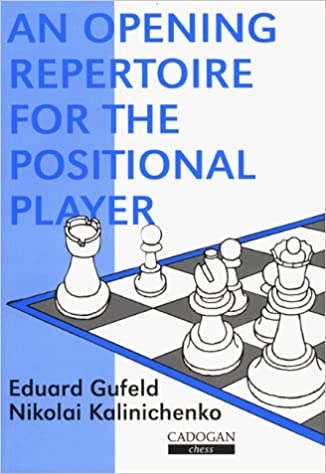An Opening Repertoire for the Positional Player - Eduard Gufeld
This book provides a solid repertoire for the positional player based on 1. e4 and White, and meeting it with the Classical Sicilian Defence, and meeting 1. d4 with the King’s Indian Defence. It gathers together solid and reliable lines of play, and covers games played up to the first half of 1997.
Repertoire as White
White’s opening repertoire is based on 1. e4 and king’s pawn openings.
Chapter 1 - The Sicilian Defence. Gufeld suggests the Alapin c3-Sicilian, aiming to creating a strong pawn centre. The variation coverage shows a bent towards closed centre positions in Black’s weaker options, leaving White free to operate on the wings. Black’s stronger options tend towards open French Tarrasch positions. The single illustrative game is from the 1996 Deep Blue vs Kasparov match.
Chapter 2 lays out the Four Knights Scotch Game against 1… e5, initiating active piece play in the centre. But through a Vienna Game move-order (2. Nc3 followed by 3. Nf3) to avoid the Philidor Defence and Latvian Gambit. The illustrative is a Rublevsky miniature against Onischuk.
Against the French Defence in Chapter 3, Gufeld offers the Tarrasch 3. Nd2 because of it’s reliability and aiming to restrict Black’s counterplay. Surprisingly he offers a promising pawn sacrifice to counter Black’s 3… Nc6 Guimard variation. But it’s strictly the Classical approach against the closed French Tarrasch (3… Nf6), aiming to swap off the dark-squared bishops with 12. Bf4, and taking the initiative through the centre against the 8… Qb6 system. Against the “only correct” response 3… c5 (quoting Sveshnikov), Gufeld offers Alekhine’s plan of rapid development (4. Ngf3).
Chapter 4 advocates Short’s Variation against the Caro-Kann (3. e5 and 4. Nf3), not chasing the Black light-squared bishop around. This gives White a possibility of playing c2-c4.
Against the Pirc/Umfitsev (and by transposition, in the Modern Defence), Gufeld covers bolstering White’s pawn centre with 3. f3, and develop harmoniously. White aims for a slight but persistent advantage. The Alekhine’s Defence is met by the Classical 4. Nf3.
Repertoire as Black
As Black against 1. e4 Gufeld recommends the Classical Sicilian. For move 2 and move 3 deviations Gufeld refers the reader to his “Opening Repertoire for the Attacking Player”, including facing the c3 Sicilian.
This leaves coverage of the Open Sicilian, Black playing 2… d6 to sidestep an awkward line or two. Gufeld covers lines against both the Rauzer (6. Bg5, with the positionally well-founded 6… Bd7), and the Sozin (6. Bc4, offers Kramnik’s patent weapon 6… Qb6), and suggesting Black transposes into a Classical Dragon against 6. Be2 and 6. f4 (and again, points the reader to his companion “attacking player” repertoire).
Against 1. d4 Gufeld choses the King’s Indian Defence, based on it’s flexible and universal nature that can be used against practically any move order (apart from 1. e4). Rapid mobilisation of the queenside pawns against the Four Pawns Attack is covered in Chapter 5.
Chapter 9: against the Sämisch variation Gufeld advocates completing development with Panov’s 6… Nc6, and expanding on the queenside, and holding back White’s kingside attack with a timely … h5.
Chapter 10 Gufeld suggests queenside play against the g3 Kings Indian setup, after ceding the center with … exd4, following in the footsteps of Bronstein’s experience in these lines (and later adopted by Kasparov).
Chapter 11 covers the Classical Variation, Gufeld covers the Petrosian Variation (7. d5), the Gligoric variation (7. Be3), and finally the main-line he avoids the long theoretical lines suggesting Black give up his centre with 7… exd4, aiming to complete his development and piece play around White’s centre (following GM Glek).
Chapter 12 covers earlier deviations from the mainline King’s Indian systems, covering the Sämisch-like 6. Nge2, 6. Bd3, Makogonov’s 6. h3, 6. Be3, the Romanian 6. Bg5
Chapter 13 covers the Averbakh initiative-stifling variation of the King’s Indian Defence, replying with the critical 6… c5 with Benoni-like play after a later … e6, and … exd5.
The Torre Attack is covered in Chapter 14, Gufeld recommending …c5 based King’s Indian setups, similar to the Averbakh lines. Against the Trompowsky, in Chapter 15, Gufeld opts for the critical 2… Ne4 followed by 3… c5.
Unsurprisingly against the English Opening, Gufeld turns to the flexibility of the King’s Indian setup. But there’s just one opening system considered where White opts for an extended queenside fianchetto setup. Then finally in Chapter 17, against the Bird Gufeld essays 1… d5 followed by a kingside fianchetto.

- Title
- An Opening Repertoire for the Positional Player
- ISBN
- 1857441524
- Author(s)
-
Gufeld, Eduard
Kalinichenko, Nikolai
- Publisher
- Cadogan Chess
- Year
- 1997